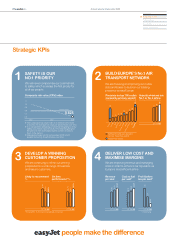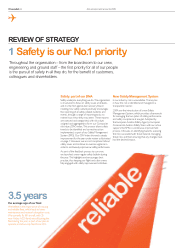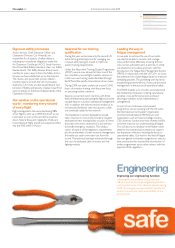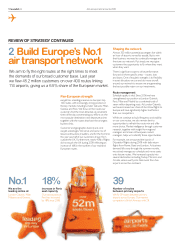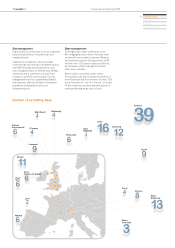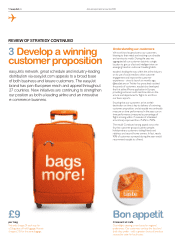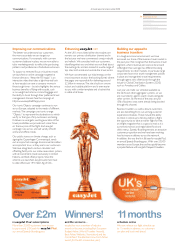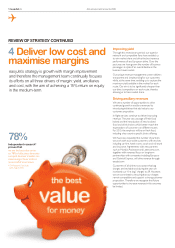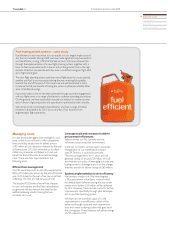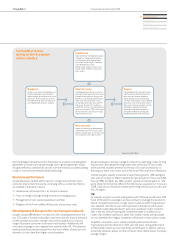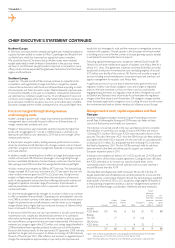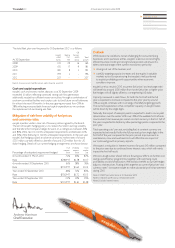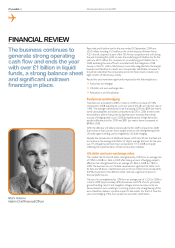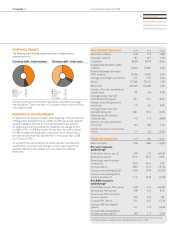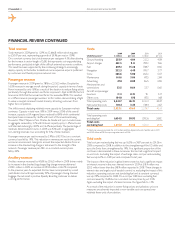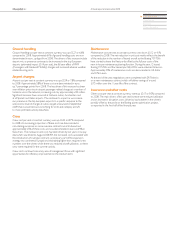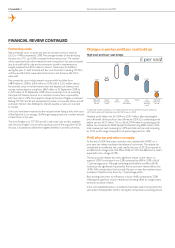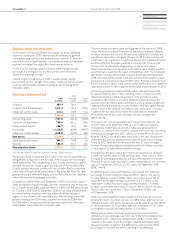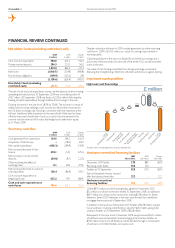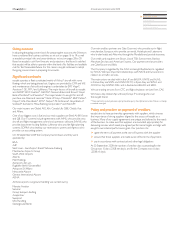EasyJet 2009 Annual Report Download - page 19
Download and view the complete annual report
Please find page 19 of the 2009 EasyJet annual report below. You can navigate through the pages in the report by either clicking on the pages listed below, or by using the keyword search tool below to find specific information within the annual report.
Annual report and accounts 200917 easyJet plc
q
Overview
Business review
Governance
Accounts
Other information
the Copenhagen Climate Summit in December to produce a sensible global
agreement on aviation and climate change. Such a global agreement should
recognise efciency standards for aircraft, with the emphasis on planes utilising
modern, more environmentally friendly technology.
Business performance
easyJet delivered a resilient performance in a tough and uncertain macro
economic environment this year by continuing to focus on the four themes
we outlined in the Interim report:
Development of Europe’s No.1 air transport network
q
Focus on margins through driving revenue and managing costs q
Management of cash, capital expenditure and eet q
Mitigation of risk from volatility of fuel prices and currency rates q
Development of Europe’s No.1 air transport network
easyJet’s unique differentiator is its network, with a leading presence on the
top 100 routes in Europe and positions at primary airports that are attractive
to time sensitive consumers. easyJet’s network has appeal across a broad
range of European consumers both leisure and business. Additionally, half
of easyJet’s passengers now originate from outside of the UK. This balanced
revenue base has protected easyJet from the worst effects of recession and
allowed us to win share from higher cost competitors.
easyJet continued to actively manage its network by optimising routes. During
the past year, 28 underperforming routes were closed and 70 new routes
were launched. easyJet’s presence on the top 100 routes increased by six
following our entry onto routes such as Rome to Milan and Paris to Barcelona.
Overall, easyJet’s capacity (measured in seats own) grew by 1.8% during the
year, with an increase of 16% in mainland Europe, focused on France (up 30%),
Italy (up 78%) and Spain (up 16%). easyJet’s capacity at Gatwick grew by 12%,
partly driven by the full year effect of the GB Airways acquisition on 31 January
2008. Capacity was reduced in weaker performing markets such as Luton and
the UK regions.
UK
At Gatwick, easyJet is now the leading airline with 39 based aircraft and a 30%
share of the airport’s passengers and we continue to leverage that position to
absorb competitive pressures. Longer sector routes are performing well and
slots acquired with GB Airways were optimised in the period with business
orientated routes being allocated to peak slots and leisure routes moved to
later in the day. We are winning the competitive battle on traditional sun
routes with excellent load factors, albeit with weaker market pricing. easyJet
has also beneted from legacy competitor withdrawal on key business routes.
At Belfast, competitors are in retreat and both yields and load factors
improved towards the latter part of the year. We had a strong performance
at Manchester, where we now have three aircraft based. In addition, we have
proactively reduced capacity at other UK bases which deliver below Company
average margins.
Competitive forces
acting on the European
airline industry
Internal rivalry
Consolidation over the past year has
lowered the competitive pressures on
Europe’s leading airlines. easyJet and
Ryanair are increasingly dominant on
short-haul whilst long-haul travel is
increasingly dominated by just three
airlines: Air France-KLM, Lufthansa
and British Airways. Transatlantic joint
ventures between STAR and Skyteam
alliance members are also serving to
reduce internal rivalry.
Suppliers
Airpor ts are natural monopolies and,
despite regulation, have passed on
higher charges to airlines over the last
two years. Airlines continue to have
little control over their fuel costs but
use hedging tools to lower volatility.
Substitutes
High speed train development across
Europe has strong political backing
and will continue to replace ights
with short sector lengths. However
such development is only
economically viable on major trunk
routes under 1,000km that do not
cross water.
Buyers
Consolidation of the network airlines
and the demise of the business class
only start-ups has diminished the
choice for consumers on long-haul.
On short-haul easyJet is now providing
consumers with an alternative to the
ag carrier at primary airpor ts but the
reduction in capacity by the tour
operators and weaker airlines has
strengthened Ryanair and easyJet’s
bargaining position with consumers.
New entrants
Access to nancing has deteriorated
substantially over the last year which
makes it unlikely that we will see many
new entrants in the medium term.
Source: Deutsche Bank


